
I won’t sugarcoat it, not even a little bit: the music business is hard. Exceptionally hard. But since the rewards for those who make it to the top are stupendous, it’s only fitting that climb itself be difficult.
This, of course, isn’t news to you. Even the most starry-eyed musicians understand that making it as a professional artist requires talent, dedication, and more than a little luck.
What it also needs is a rock solid music marketing plan.
Musicians, in general, aren’t trained to think in terms of “positioning” or “branding”. The dogma of talent is so strong within the industry that terms like “marketing” seem almost cheap.
But if you have to stand out and make it, an ad-hoc, haphazard approach to selling yourself won’t do. Rather, you need a systemic, organized, and detailed marketing plan.
I’ll help you put together a marketing plan from scratch in this guide.
What is a Music Marketing Plan & Why Do You Need One?
“The music business is a cruel and shallow money trench, a long plastic hallway where thieves and pimps run free, and good men die like dogs. There’s also a negative side.” – Hunter S. Thompson.
Let’s start with the basics first. A marketing plan is a document that describes all your marketing approaches within a specific time frame (usually 1 year but can also be 5 years for younger businesses, although you’d want to adjust it along the way in that case).
It can be as short as a paragraph or run as long as a paperback novel. What you include in it (and more importantly, what you omit) is entirely up to you.
Having said that, most competent marketing plans for musicians describe at least the following:
- What message you’re trying to promote
- Who you will promote this message to
- Where you will promote this message
Although it’s not quite as simple for musicians, most plans should have milestone goals based on measurable metrics, like the number of downloads or plays on Spotify and Soundcloud.
If you don’t have specific numbers to drive towards, you can squander your time doing the wrong things. You must have S.M.A.R.T. goals.
In the business world, businesses often create marketing plans to convince investors that they actually know what they’re doing. This is exactly how it works these days in terms of being signed to a record deal on a large label.
Other times, businesses create plans for themselves – so that they know what they have to do and at what time. There’s no situation where you won’t benefit from this effort.

Because of this, businesses place a premium on well-developed marketing plans. All reputable business sources emphatically declare similar sentiments, such as:
“Marketing plans are critically important tools for marketing executives. If you can’t create a strong marketing plan, it is unlikely that you will be successful”. – Harvard Business Review
But that’s all good for businesses. You might think (and rightfully so) – why should I bother with marketing plans as a musician?
Why Musicians Need Marketing Plans
Unless you have a background in it, chances are that marketing isn’t your strongest suit. Sure, you might have an intuitive grasp of branding and messaging, but you still need a well-defined strategy to distribute this message to the right audience.
More importantly, you need a long-term, strategic, and structured approach to marketing.
You shouldn’t have to wake up in the morning and wonder “how will I sell my music today?”.
Rather, you should know exactly what you have to do and at what time – weeks and even months in advance.
A marketing plan helps you achieve all this, and more. It tells you:
- What marketing activities you have to do and in what time frame.
- Who your target audience is, where they hang out, and what’s the best way to reach them.
- Where you currently stand and where you ought to be in a month, a quarter, and a year from now.
- Your core marketing message and primary distribution channels (i.e. your marketing mix).
- What marketing collateral (such as websites and videos) you already have, and what you might need.
A marketing plan gives you direction. It turns ad-hoc, spur-of-the-moment marketing decisions into long-term, strategic activities. It gives you a framework to assess your marketing performance and stops you from being overwhelmed.
Now the obvious question: how exactly do you create a comprehensive marketing plan? I’ll share some answers in the next section.
A Step-by-Step Process to Create a Music Marketing Plan
Before we start, understand that an in-depth marketing plan is always difficult to create. Set aside at least a few days to collect data, research audiences, and think strategically.
A note about formats: Conventional marketing plans are often pitched to investors. Hence, they usually follow a fixed format with specifc sections – summary, goals, competencies, target audience, etc.
You don’t have to pitch anything to investors, of course. So feel free to skip or add sections as necessary. With that out of the way, let’s get started.
Step 1: Define Your Audience
One of the most common mistakes I see musicians make is to define their vision and brand before they define their audience. In marketing terms, this would be the equivalent of placing the cart before the horse.
You have to know your demographic and how many people are in it before you can set any other goals. Everything else springs from your audience, too. How you pitch yourself will depend entirely on the kind of people you want to attract.
Sure, you’ll have your own individual twist on it based on your personal vision, but you have to keep your audience at the heart of your marketing approach. You can’t use the same approach to attract 18-year old EDM fans as you would to market a Grateful Dead cover band.
So how exactly do you go about defining your audience? I’ll share a few tactics below.
Use Facebook Audience Insights
Musicians benefit a great deal from the fact that they operate within genres. Since most genres have fairly isolated demgraphics, it is easy to drill down and find your target market and create a psychographic identity for it. The more specific the genre, the easier this exercise will be.
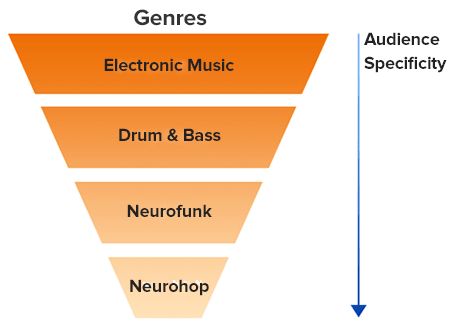
This brings us to the question of demographics and psychographics:
- Demographics define factual evidence about your audience, namely its age range, gender distribution, income distribution, marital status, and education level.
- Psychographics define your audience’s interests, affiliations, and favorite activities. They tell you what sites your audience likes to visit, what movies they like to watch, and what sports they like to play, among others.
If you can figure out these two things about your audience, you’ll be much, much closer to understanding them. One way to do this, perhaps the easiest and least expensive, is to use Facebook data.
Log into your Facebook account. Click on “Manage Ads” in the top right menu.
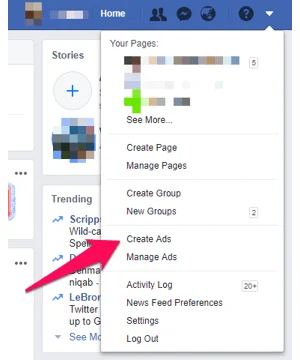
Click the “Facebook Ads” menu on the next screen. Scroll over to “All Tools” and click on “Audience Insights.” On the next screen, select “Everyone on Facebook”.
Now in the left pane, enter your music’s genre in the ‘Interests’ tab. The more specific the genre, the more accurate your data (i.e. “Electro” will be more targeted than “Electronic Dance Music,” which is still more targeted than “Electronic Music” as a whole).
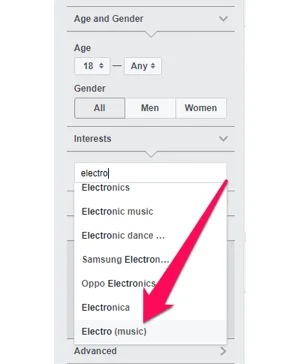
If you can’t find your music’s genre, you can do two things:
- Find a musician whose music is very similar to yours.
- Find a broader genre (such as “Hip Hop” instead of “Trap”).
Once you’ve found your genre or musician in the Interests list, take a look at the audience demographics on the right. Note the gender distribution, relationship status, and education level. For instance, Facebook tells me that of the 2.5M people who’ve shown an interest in Trap music, 61% are men.
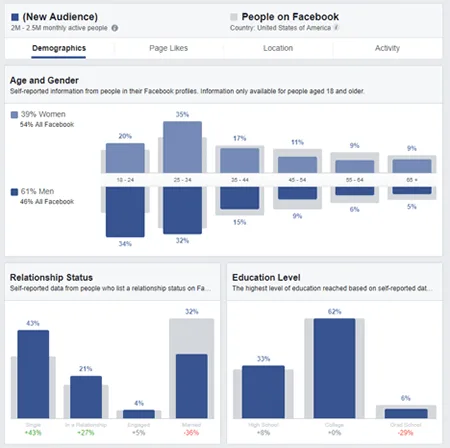
In contrast, a majority of Electro music fans are female. This immediately gives me an idea about the kind of audience I should target. But that’s not all. Facebook’s Audience Insights also shows your target audience’s interests.
Just click on the “Page Likes” links to get started. Make a note of what kind of brands, websites, products, etc., your audience likes.
For example, this is what Facebook says Electro music fans like:
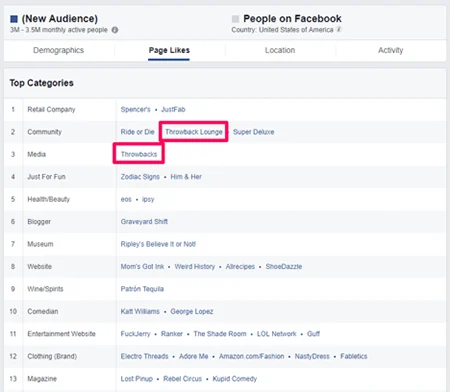
Note the “Throwbacks” and “Throwback Lounge” pages in this list. Both these pages focus on nostalgic, retro content. This tells me that fans of Electro music also have an interest in retro stuff, especially ‘80s nostalgia. If I was running a marketing campaign or figuring out my band’s brand, this would be a great angle to adopt.
Try to drill down further by adding specific musicians to your Interests list. Draw insight from different page likes. You’ll have to do some brainstorming, but more than likely since you’re also a fan you’ll understand quickly the conclusions these clues lead towards.
Use this data to answer questions like:
- What kind of websites or magazines do these people like?
- What kind of content do these publications have?
- Are their favorite products expensive/cheap/classy/modern, etc.?
- What kind of things their favorite public figures stand for?
You’ll use this data in the next step to create an audience persona, which is a condensed combination of demographics and psychographics.
Create an audience persona
An audience persona is a rough sketch of your ideal audience. This is someone you’d want to have listening to and promoting your music. You can create disciples out of your most hardcore fans who will perform better and faster promotion for you than any money could buy.
It is common practice to give a specific name, age, and face to your audience persona. This one abstract person symbolizes the entire audience group.
For example, here’s an example audience persona of a prospective student courtesy of GMAC. It defines the student’s interests, activities, experience, and gives her a name and a face.
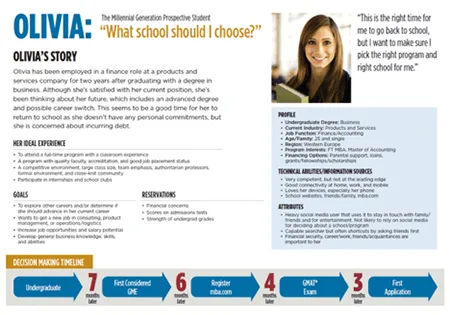
Since you already have so much data from Facebook, creating your audience persona should be very easy.
Regardless of what persona template you use (you can find some online that will prompt you with fields to fill in), you should have the following details:
- A fictional name (you want to personalize it so you think more realistically about this in general)
- Gender and approximate age based on Facebook audience data
- A picture of what you think this person looks like (use can use a free stock image if you will distribute this information)
- A list of interests, including hobbies, favorite websites, products, public figures, etc.
- A list of favorite artists, particularly musicians
- Location (rural, urban, semi-urban), education level (college, high-school, grad school), and income level as per Facebook data. You can find more details using Alexa’s competitor analysis tool for similar musician’s websites)
- Core values and defining traits (such as “nostalgic”, “90’s mom”, “open to new experiences”, etc.)
- A persona summary, such as their current life’s goals, reservations, ideal experiences, and backgrounds.
You should have at least one persona in your music marketing plan. Of course, you can have more than one based on interest groups (such as one for Electro music fans and another for Trap fans).
Once you’ve defined your audience, you can start understanding your message and positioning.
Step 2: Define Your Message, Vision, & Brand
Your “brand” is (should be) a careful amalgamation of two things:
- What your audience wants
- What you want
A strong brand will have a healthy mix of the two. Focus too much on the audience and you’ll have a brand that feels like it was made by a big label corporate marketing department that only cares about siphoning fan’s money up. Swing too much in the other direction and you might find that you and your music are too obscure and unmarketable.
So before you start defining your message, vision, and brand, list down the following:
- Artists whose music you admire
- Artists whose brand you admire
- Your core values and the values your music aligns with (you can’t play punk and have a family-friendly brand, for instance)
- Your visual tastes, influences, and inspirations
- Your favorite music videos, album covers, lyrics, etc.
This is a complicated and time-consuming exercise. Give it at least a weekend of deep thought. I recommend creating a Pinterest account and several boards to gather all your inspiration into one organized spot. Collect everything from album covers to concert stage designs that inspire you.
Next, do the same exercise, but this time, for your target audience persona. Find the values, artists, visual tastes, etc. they’re inspired by.
Your goal should be to find a common point between your tastes and those of your target audience’s. For example, in our above analysis, we found that our target persona likes ‘80s and ‘90s inspired content. If you search for “80’s album covers” on Pinterest, you would see something like this:
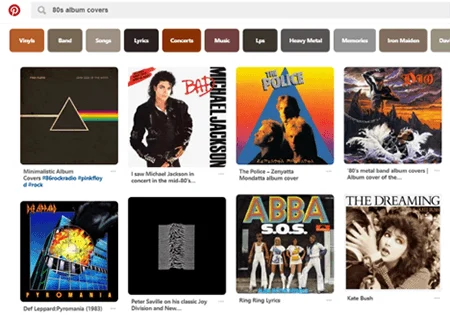
All these covers have a distinct visual style – geometric shapes, bold colors, etc. Ask yourself: does this style inspire me? Could I adopt it in some fashion in my own music and marketing?
If the answer to these questions is “yes”, then congratulations – you’ve got the first piece of the jigsaw puzzle that makes up your brand. Do this for different aspects of your target audience’s and your own tastes and interests.
Dig through their favorite lyrics, then compare them to yours. See what they sing about – partying, love, home, injustices, etc. While doing this, also be aware of genre conventions. People expect an electronic music album to look and feel a certain way.
This will be very different from what people expect a death metal album to look like. If you stray too far from conventions, you ostracize your potential listeners. Everything must feel familiar to them to capture their attention first and then their affection.
This is a lot of homework, but doing it will help you come closer to defining a brand that is both personal and commercial.
Step 3: Define Your Marketing Mix
Your “marketing mix” is the combination of channels, platforms, and mediums you’ll use to promote your music. What kind of marketing mix you use will depend on three things:
- Your budget
- Your existing marketing expertise
- Where your target audience hangs out
The most important element among these is the last one – where your audience hangs out. Since you’ve already defined your audience, you would have a basic idea of your audience’s interests. Your job now is to figure out what websites, social media accounts, and blogs they hang out on. Here are some ways to do this:
Find relevant YouTube channels: Search for your target genre on YouTube. Make a list of all the medium to big sized channels that have content related to the genre. Also note their total subscribers, how often they update, and their contact information (if publicly listed). For example, this is what I see when i search for “chillhop”:
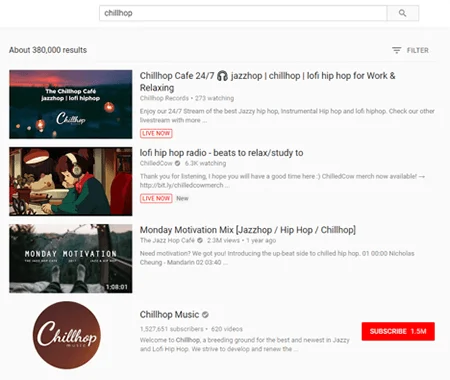
Find targeted Instagram accounts and hashtags: Search for your music genre on Instagram. Make a list of all accounts that show up as well as any relevant hashtags. For example, here’s what I see for “chillhop”:
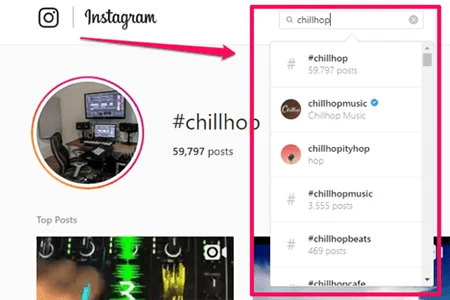
Now open a few posts from your search. Make a list of any relevant hashtags they’re using in their promotion. Use these hashtags to expand your search. Your goal is to find accounts that might promote your music, as well as effective hashtags to use in your own posts. Make a list of all such accounts along with their contact details.
Find bloggers and music journalists: Search for the following on Google: “[your music genre] + blog” without the quotation marks. Make a list of all such blogs you find. Note whether they accept outside submissions. If they do, note their submission requirements and contact details.
Our friend Ryan over at MidiNation saved you some homework by putting together a list of 100 music blogs. But you should nevertheless search on your own to find additional blogs. Music marketing outreach is a numbers game. Add these websites to your list of YouTube channels and Instagram accounts.
If you have the time, you can become involved in music communities online. Even if you can only make the rare appearance, that can be even more valuable since you’ll exemplify exclusivity and a sense of scarcity. Our write up on building a reputation as a beat producer lays out a ton of tactics in this regard and is worth your time if you’re in the earlier stages of your career.
Find SoundCloud accounts and Spotify playlists: Next, search SoundCloud for your genre. Look out for any accounts that post new music from unsigned artists. Note their account details.
These can get you in front of a lot of curious listeners seeking new artists to be fans of in order to seem hip and in the know. They’ll promote you a ton in order to make sure others understand how underground and in the music scene they are.
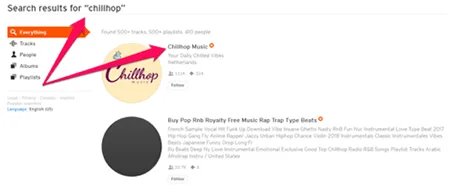
Now do the same on Spotify but focus on playlists. Your goal is to get your music on curated playlists. Make a lists of any such playlists you find so you can try to find methods of contact with the creator.
What happens is fans of other similar artists then learn about you and you can siphon and share some of their fan base. If your brand becomes strong enough, you can network with these other musicians to reinforce your validity and value to these new fans.
Step 4: Define Your Budget & Marketing Capabilities
Plenty of targets you’ll find during the process above will help you for free. Some, however, will want something in return – cross-promotion, or more often, cash. Your job now is to figure out what marketing channels you’re the most comfortable with, and how much you can spend on each based on your budget.
For example, if you’ve never used Facebook/Instagram ads before and have a small budget, it won’t be worth your time to promote yourself on Instagram. You’ll spend a good amount making mistakes and collecting data before you can optimize your campaigns.
On the other hand, if you’re great with email and love to build relationships, reaching out to music bloggers might be a great tactic.
Identify the following:
- Your comfort level with different marketing channels (Facebook/Instagram, YouTube, SoundCloud, etc.)
- Your strongest marketing skills (outreach, social media marketing, paid acquisition, etc.)
- Your existing marketing collateral (videos, promotional graphics, free singles or EP’s, etc.)
I also recommend figuring out the approximate cost of promotion on each channel. Try emailing a few top targets on YouTube, Instagram, SoundCloud, and music blogs and ask for the price of their paid promotion packages as well as analytics.
Ask for how many views/plays you can expect on average from each promotion. This will help you identify the “cost per view/listen” (CPV) – a key metric when distributing your marketing budget.
With all this data, you can now create your marketing mix.
Step 5: Create Your Music Marketing Plan
With all the homework you’ve done, you’re finally ready to put together a marketing plan. A conventional marketing plan has a few more sections that musicians won’t find as useful as a business in a competitive industry.
You’re not a business; you don’t really have competitors that you need to do a SWOT analysis for. Nor do you need a “mission statement” – that’s something for investors and senior managers to ponder over.
So for now, we’ll skip those sections. Instead, our marketing plan will include the following:
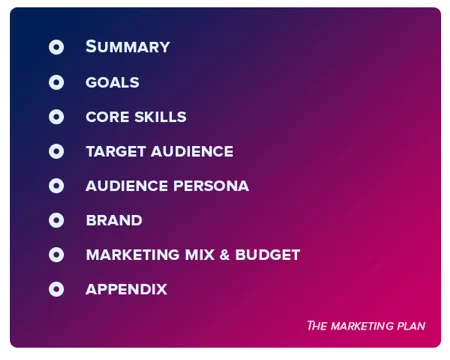
Summary: A high-level summary of the music marketing plan. Write this only after you’ve filled up the remaining sections.
Goals: Your primary and secondary goals. I recommend tying these to specific metrics, such as YouTube subscribers, SoundCloud plays, etc. Thus, your goals might look something like this:
- Primary goal: Increase YouTube subscribers to 10,000
- Secondary goals: Get 10,000 followers on Instagram and Soundcloud
Core skills: What marketing skills or experience you already have. This should include any marketing collateral you’ve already created. I also recommend listing any desired skills you want along with how difficult it is to learn them, perhaps on a scale of one to ten.
Target audience: This should be a detailed summary of your target persona(s), as mentioned above. Try to condense your findings from Step 1 in this section.
Audience persona: Attach a copy of your audience persona document in this section. You can also include it at the end as part of the appendix.
Brand: Use this section to summarize your brand, its values, and its vision. Condense all your findings from Step 2 here.
For example, you might have something like this:
- Values: Fun, vibrant, bold, etc.
- Aesthetic: California summer/tropical, 80’s neon wave, bold colors, geometric shapes
- Musical inspiration: Get Lucky by Daft Punk, Depeche Mode, etc.
- Slogan/motto: (Condense your brand in a single, marketable sentence).
Include a link to or a screenshot of the Pinterest mood board you created in Step 2.
Marketing mix and budget: Summarize your marketing mix and budget based on the information from Step 3. Identify how much money you’ll have to spend and where you’ll spend it. Also identify free sources of traffic and how you’ll distribute your time on them.
These can be fantastic but don’t fall in the trap of using them exclusively because they’re free. They’re slower as well if you don’t have the marketing acumen to pull it off.
Appendix: Attach any relevant documents in this section. This can include your list of websites/social media accounts, audience persona documents, etc.
Now You Have a Music Marketing Plan!
Congratulations – if you’ve done all the above, you would now have a complete marketing plan! Instead of making ad-hoc decisions, you can now consult this plan to promote your highly targeted brand to a well-defined audience without overshooting your budget. Creating a music marketing plan might be a lot of effort, but the results are undoubtedly worth it.